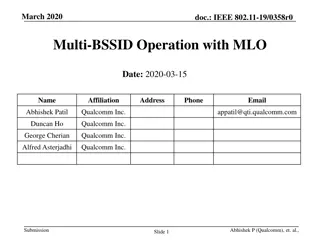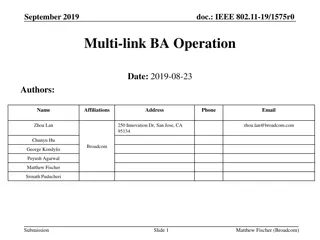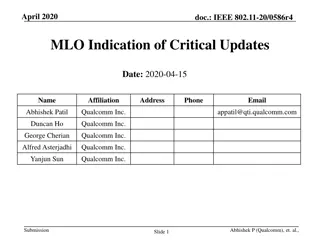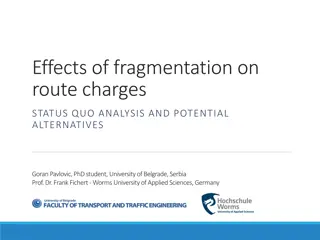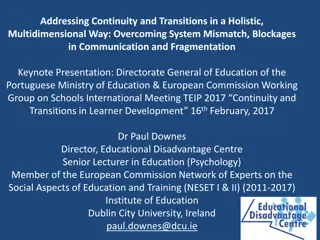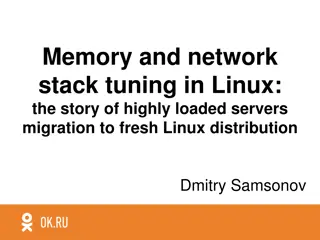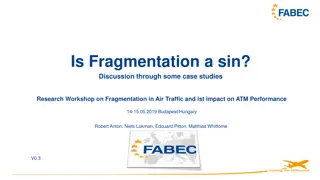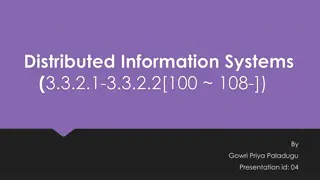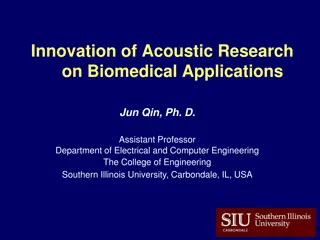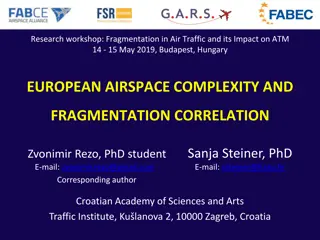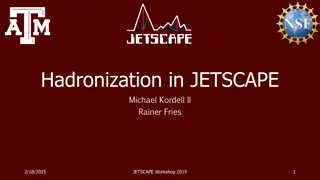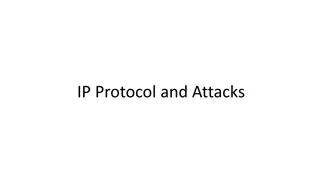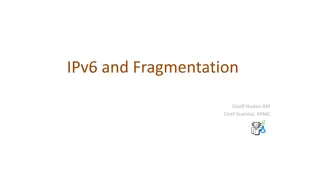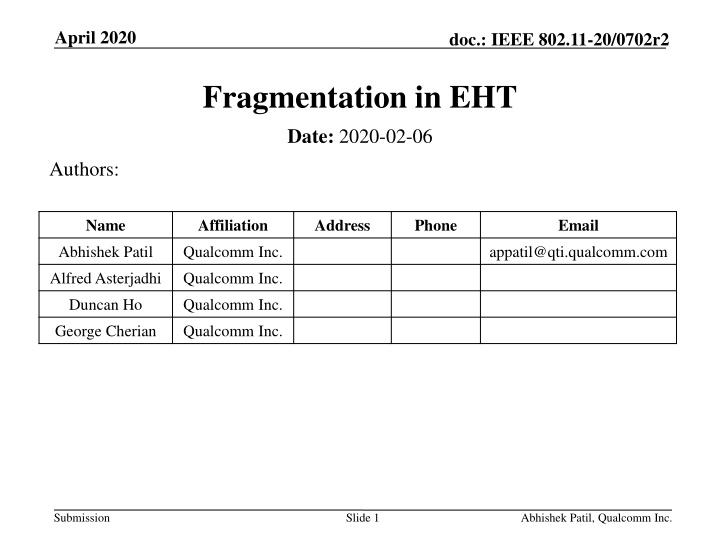
Understanding Fragmentation in IEEE 802.11-20 for Enhanced High Throughput
Explore the impact of fragmentation on EHT design in IEEE 802.11-20 standard, covering static and dynamic fragmentation methods. Learn about the proposals to enhance efficiency for EHT STAs through dynamic fragmentation options.
Download Presentation

Please find below an Image/Link to download the presentation.
The content on the website is provided AS IS for your information and personal use only. It may not be sold, licensed, or shared on other websites without obtaining consent from the author. If you encounter any issues during the download, it is possible that the publisher has removed the file from their server.
You are allowed to download the files provided on this website for personal or commercial use, subject to the condition that they are used lawfully. All files are the property of their respective owners.
The content on the website is provided AS IS for your information and personal use only. It may not be sold, licensed, or shared on other websites without obtaining consent from the author.
E N D
Presentation Transcript
April 2020 doc.: IEEE 802.11-20/0702r2 Fragmentation in EHT Date: 2020-02-06 Authors: Name Affiliation Address Phone Email Abhishek Patil Qualcomm Inc. appatil@qti.qualcomm.com Alfred Asterjadhi Qualcomm Inc. Duncan Ho Qualcomm Inc. George Cherian Qualcomm Inc. Submission Slide 1 Abhishek Patil, Qualcomm Inc.
April 2020 doc.: IEEE 802.11-20/0702r2 Introduction EHT is significantly increasing the achievable throughput due to Increase of BW to 320 MHz, SSs to 16, QAM constellation to 4K, Introduction of multi-link operation, etc. In this contribution we discuss fragmentation, its variants and the impact on the design of EHT STAs Submission Slide 2 Abhishek Patil, Qualcomm Inc.
April 2020 doc.: IEEE 802.11-20/0702r2 Baseline Fragmentation Static frag. splits an MSDU into multiple fragments, with each fragment Having equal length, except for the last one that can be smaller. Soliciting an immediate Ack frame This type of fragmentation Is used at low data rates regimes and in bad channel conditions Requires high overhead compared to useful information delivered Each fragment has its own MAC header, SIFS, Ack frame, etc. Leading to increased airtime and latency, and reduced efficiency EHT STAs target extremely high throughputs, among other things Targets which can be impacted by static fragmentation Propose to disallow static frag. or make it optional (RX) At least consider disallowing for EHT STAs that are MLO STAs since it adds complexity with no benefits Submission Slide 3 Abhishek Patil, Qualcomm Inc.
April 2020 doc.: IEEE 802.11-20/0702r2 Dynamic fragmentation Dynamic fragmentation splits an (A)MSDU into multiple fragments, wherein each fragment Has a length different from that of other fragments of same (A-)MSDU Solicits an Ack, (M-)BlockAck, depending on the level of fragmentation This type of fragmentation is used for high efficiency (HE) Replaces padding that is otherwise needed in HE MU/TB PPDUs Can be used for low data rates and/or extended range scenarios (on a single link) This type of functionality is beneficial for EHT STAs Helps to improve efficiency, and reduce overhead, wherever necessary Similar to the HE use cases (e.g., low data rate / extended range over a single link) Propose to preserve the optionality of this feature for EHT Additional details in following slides Submission Slide 4 Abhishek Patil, Qualcomm Inc.
April 2020 doc.: IEEE 802.11-20/0702r2 Dynamic Fragmentation (Cont.) Currently a STA declares its support for dynamic fragmentation along with a variety of parameters via HE Capabilities IE that it transmits E.g., number of fragments, level of fragmentation, etc. Proposal: For multi-link these parameters are at the MLD level During BA setup, the MLDs can negotiate different levels of dynamic fragmentation on a per-TID basis In ADDBA Extension IE included in ADDBA Request/ADDBA Response frame (i.e., reuse existing 11ax framework) Submission Slide 5 Abhishek Patil, Qualcomm Inc.
April 2020 doc.: IEEE 802.11-20/0702r2 Dynamic Fragmentation (Cont.) Handling in a multi-link setting will require some considerations If link-level fragmentation is used, there is a high risk that a fragment can get stuck on a congested link which would prevent the BA window from advancing further Thus bringing down the overall thruput and going against the charter of EHT. MLO provides link diversity which means if conditions deteriorate on a link, a fragment can be attempted on another link Therefore we propose that dynamic fragmentation must be performed at the MLD level Submission Slide 6 Abhishek Patil, Qualcomm Inc.
April 2020 doc.: IEEE 802.11-20/0702r2 Dynamic Fragmentation (Cont.) A STA transmits fragment(s) and reports to MLD the portion of MSDU which did not make it through i.e., transmitting STA uses explicit acknowledgment functionalities (defined in 11ax) to ensure the successful delivery of a portion of the MSDU Receive status of MSDUs that are fragmented is maintained at the MLD Fragment can be sent on any link as long as the fragment size and contents remain unchanged An MLD may attempt to retransmit a failed fragment on any link An MLD may not be capable of receiving fragments of an MSDU Define a bit to indicate if the MLD supports receiving fragment from a peer MLD. Originator may perform fragmentation and transmit frames of an MSDU only if the receiving MLD has indicated support (i.e., bit set to 1) Submission Slide 7 Abhishek Patil, Qualcomm Inc.
April 2020 doc.: IEEE 802.11-20/0702r2 Disallow Fragmentation for R1 In order to keep things simple and meet the R1 timeframe, we recommend disallowing fragmentation in R1 i.e., set the bit to 0 and provide rules at the transmitter to honor this bit Then in R2, we can discussion and provide details in the spec on fragmentation for MLO (i.e., the proposal in previous the slides) Submission Slide 8 Abhishek Patil, Qualcomm Inc.
April 2020 doc.: IEEE 802.11-20/0702r2 Summary We discuss fragmentation for EHT STAs and propose to Disallow or make optional static fragmentation for EHT Propose to have a receiver capability to indicate if the recipient can receive fragments of the same MSDU on more than one link Propose to move fragmentation under MLO to R2 to keep things simple for R1 For R2, negotiate dynamic fragmentation at the MLD level which allows, a fragment may be retransmitted on any link of the MLD Submission Slide 9 Abhishek Patil, Qualcomm Inc.
April 2020 doc.: IEEE 802.11-20/0702r2 Additional discussion Disallow static fragmentation in MLO Static fragmentation: used in low data rate regimes and highly inefficient Will have adverse impact on performance of an EHT STA An MLD can always pick a different/better link when the conditions on a certain link deteriorate There are different opinions about dynamic fragmentation (link vs MLD level). In our view, dynamic fragmentation at MLD level will provide the most benefit. STAs of an MLD share the same sequence number space along with a common BA scoreboard therefore fragmentation at MLD level naturally fits in the design If fragmentation is performed at link-level, there is a high risk that a fragment can get stuck on a congested link which would prevent the BA window from advancing further. On the contrary, MLO provides link diversity which means if conditions deteriorate on a link, a fragment can be attempted on another link With respect to dynamic fragmentation in R1/R2: recommend disabling in R1 This gives the TGbe group more time to have a healthy discussion on the topic, e.g., Whether dynamic fragmentation should be performed at link-level or MLD-level, Whether fragmentation is possible if encryption is handled at higher layer, etc. cases brought up in 11-20/1545 (MLD Security Considerations Gaurav, HPE) It was suggested that dynamic fragmentation in R1 will be useful since it can replace padding to align Sync PPDUs However sync PPDU feature is optional and padding is conditional to sync PPDU Therefore replacing padding with fragments is a second order optimization; not a strong motive for having it in R1 Submission Slide 10 Abhishek Patil, Qualcomm Inc.
April 2020 doc.: IEEE 802.11-20/0702r2 SP 1 Do you support that the 802.11be amendment shall disallow static fragmentation in MLO? Y: N: A: Submission Slide 11 Abhishek Patil, Qualcomm Inc.
April 2020 doc.: IEEE 802.11-20/0702r2 SP 2 Do you support that dynamic fragmentation between two MLDs is not supported in R1? Y: N: A: Submission Slide 12 Abhishek Patil, Qualcomm Inc.
April 2020 doc.: IEEE 802.11-20/0702r2 SP 3 Do you support that dynamic fragmentation between two MLDs is optional for R2? Dynamic fragmentation operation between two MLDs is TBD Y: N: A: Submission Slide 13 Abhishek Patil, Qualcomm Inc.
April 2020 doc.: IEEE 802.11-20/0702r2 SP 4 Do you support to have a capability bit MLD Fragmentation in TBD element? If the bit is set to 0 by a STA affiliated with an MLD, the MLD does not support reception of a fragment from a peer MLD An MLD shall not fragment frames and send fragment to another MLD that has set this bit to 0. Note: The bit is set to 0 for R1 Y: N: A: Submission Slide 14 Abhishek Patil, Qualcomm Inc.
April 2020 doc.: IEEE 802.11-20/0702r2 APPENDIX Submission Slide 15 Abhishek Patil, Qualcomm Inc.
April 2020 doc.: IEEE 802.11-20/0702r2 Fragmentation in EHT Description Dynamic Frag. Support* (HE Caps) 0 MLD Fragmentation (EHT Caps/ML IE) 0 No support for dynamic fragmentation at any level (EHT STA or MLD DEV). No support for static fragmentation at any level (EHT STA or MLD DEV. R1 text: STA of an MLD shall not fragment frames sent to another STA of MLD that has set these bits set to these values. No R2 text. 0 1 No support for dynamic fragmentation at MLD level. Not applicable to EHT STA without MLD setup (sets new cap bit to 0). Maybe support for static fragmentation at MLD level?** No R1 text. R2 text to be dealt with later. > 0 0 Yes support for dynamic fragmentation at EHT STA (baseline). No support for dynamic fragmentation at MLD level. No support for static fragmentation at any level. No R1 text. No R2 text. > 0 1 Yes support for dynamic fragmentation at MLD level. Not applicable to EHT STA without MLD setup (sets new cap bit to 0). No support for static fragmentation at MLD level** No R1 text. R2 text to be dealt with later. *Each STA (of an MLD eventually) indicates its support in HE Caps. IE as per baseline. ** Static fragmentation can be disabled altogether. Submission Slide 16 Abhishek Patil, Qualcomm Inc.

